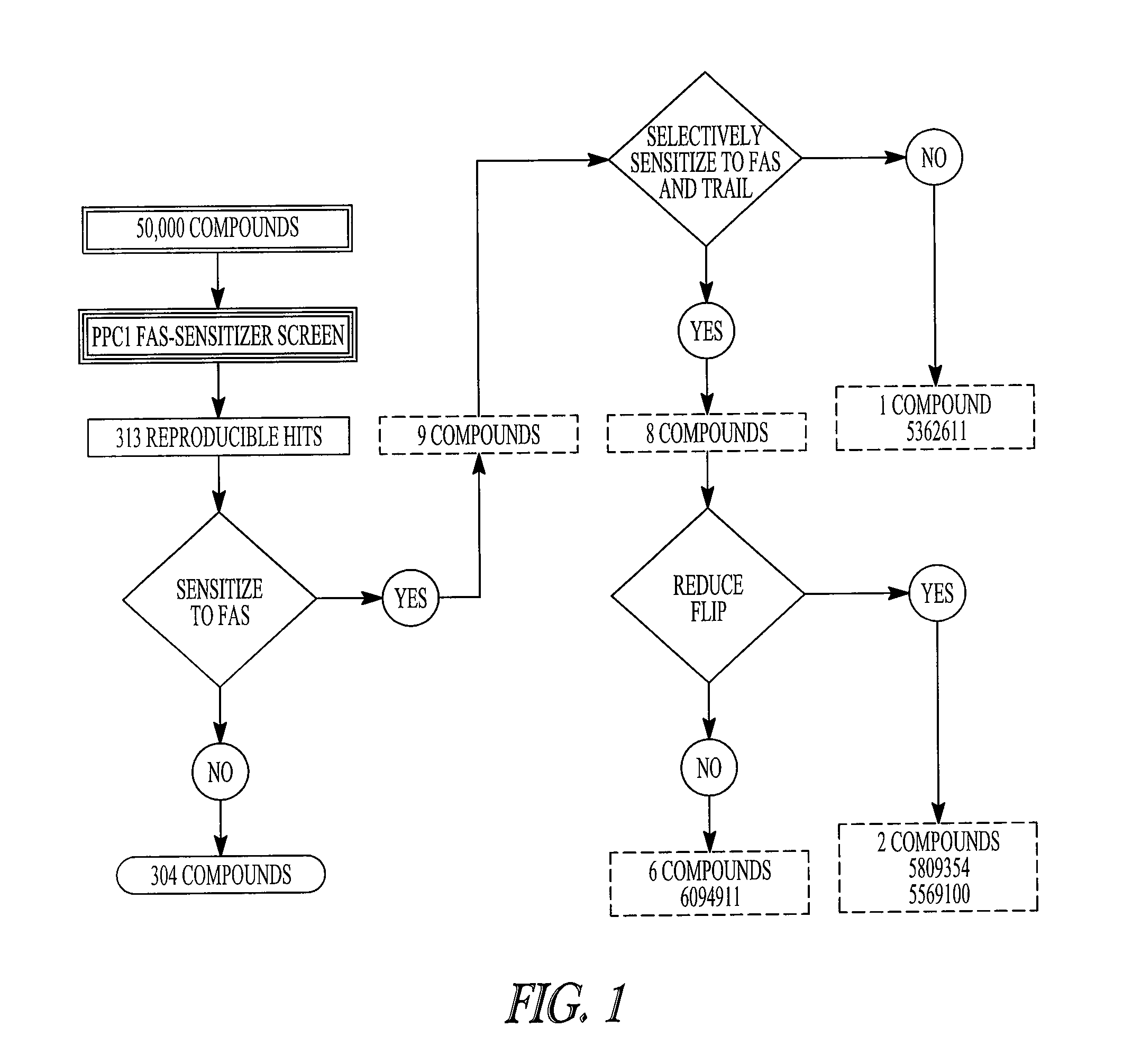Death receptor sensitizing compounds and methods of use therefor
a technology of tnf-family death receptors and sensitizing compounds, which is applied in the field of tnf-family death receptor ligand-mediated apoptosis, and can solve the problems of acquired or intrinsic resistance to tnf-family death ligands and death receptors, limit such therapies, etc., and achieve enhanced apoptosis, inhibit metastases, and enhance tnf-family death receptor ligand-mediated apopto
- Summary
- Abstract
- Description
- Claims
- Application Information
AI Technical Summary
Benefits of technology
Problems solved by technology
Method used
Image
Examples
example 1
[0372]Reagents. A 50,000 compound Diversa chemical library was obtained from Chembridge (San Diego, Calif.). The anti-FAS monoclonal antibody CH-11 was purchased from MBL (MBL, Co. Ltd., Nagoya, Japan). TRAIL was obtained from Alexis (San Diego, Calif.). VP-16 and staurosporine were purchased from Sigma (Sigma Inc., Milwaukee, Wis.). 2-cyano-3,12-dioxooleana-1,9-dien-28-oic acid (CDDO) was a generous gift from Michael Sporn (Dartmouth University).
[0373]Cell Lines. Cell lines were maintained in RPMI 1640 supplemented with 2.5-10% fetal calf serum (FCS) (Hyclone, Tulare, Calif.), 1 mM L-glutamine and antibiotics (streptomycin / penicillin). Cells were cultured at 37° C. in a humid atmosphere with 5% CO2.
[0374]High throughput screening. Screens were performed using a fully integrated, programmable robotic liquid handling system (Biomek® FX, Beckman-Coulter Inc., Fullerton, Calif.), with integrated plate reader (LJL analyst HT 96-384, Sunnyvale, Calif.) and environment...
example 2
Materials and Methods
[0402]Reagents. Anti-Fas monoclonal antibody CH-11 was purchased from MBL (Nagoya, Japan). Staurosporine was purchased from Sigma-Aldrich (Oakville, ON, Canada). z-VAD-fink was purchased from Calbiochem (San Diego, Calif., USA). 5809354 ((4-(4-chloro-2-methylphenoxy))-N-hydroxybutanamide) and 7271570 ((4-(4-chloro-2-methylphenoxy))-N-(3-ethoxypropyl)-butanamide) were obtained from Chembridge (San Diego, Calif., USA).
[0403]Cell culture. SV40-transformed wild-type and FLIP knockout MEFs (gifts from S. Benchimol and Y. C. Yeh, Princess Margaret Hospital) and E1A-transformed wild-type and caspase 8 knockout MEFs (gifts from S. Benchimol and R. Hakem, Princess Margaret Hospital) were maintained in DMEM media. PPC-1, PC-3, DU-145, LNCaP, T47D, and OVCAR-3 cells were maintained in RPMI 1640 media. DLD-1, DKS-8, and MB-MDA-468 were maintained in DMEM media. All culture media was supplemented with 10% fetal bovine serum (Hyclone, Logan, Utah, USA) and antibiotics. DsRED-...
PUM
| Property | Measurement | Unit |
|---|---|---|
| Molar density | aaaaa | aaaaa |
| Molar density | aaaaa | aaaaa |
| Molar density | aaaaa | aaaaa |
Abstract
Description
Claims
Application Information
 Login to View More
Login to View More - R&D
- Intellectual Property
- Life Sciences
- Materials
- Tech Scout
- Unparalleled Data Quality
- Higher Quality Content
- 60% Fewer Hallucinations
Browse by: Latest US Patents, China's latest patents, Technical Efficacy Thesaurus, Application Domain, Technology Topic, Popular Technical Reports.
© 2025 PatSnap. All rights reserved.Legal|Privacy policy|Modern Slavery Act Transparency Statement|Sitemap|About US| Contact US: help@patsnap.com



